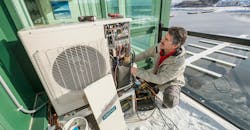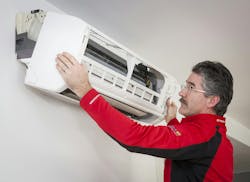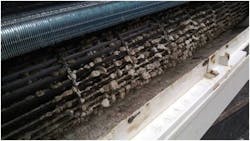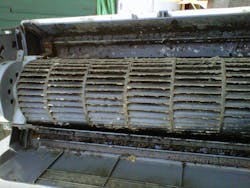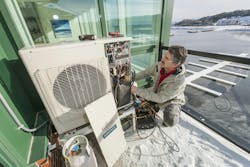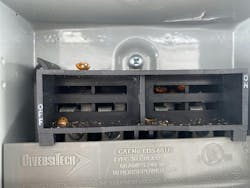In business since 2008, Comeau Comfort Systems in Bridgetown, Nova Scotia, Canada, has always focused on heat pump technology.
In our area, these systems are often installed in a retrofit application to reduce or eliminate the need for fuel oil during the heating season. The added value of air conditioning is a secondary benefit. However, this is changing with summer highs increasing seemingly every year.
Nova Scotia is a Maritime Province, meaning it typically has high humidity for much of the year. The systems that Comeau Comfort Systems installs face unique operational challenges compared to similar systems in other parts of North America.
In an average year, we will install 150 heat pump systems. Comeau Comfort Systems has been installing Fujitsu heat pumps since 2008 and became an Elite dealer in 2015 to better serve our customer base.
We learned early on that mini-split heat pumps are low maintenance, not maintenance-free, as some people tend to believe. Like any piece of equipment, mini-splits operate most efficiently and effectively when properly maintained. We know that scheduled annual maintenance provides the greatest benefits for the customer, in the form of comfort, energy savings, and system longevity.
The company has one full-time service technician on staff. The other technicians conduct service work regularly, as well. From an accounting standpoint, we treat service work the same as installation work, meaning that our profit margin for maintenance is similar to our other work. Failing to be profitable on maintenance work is why many HVAC contractors don’t take it as seriously as I believe they should.
Over the years, we’ve developed a recipe for servicing heat pumps that’s kept our clients happy, with word-of-mouth referrals a steady benefit.
Pressure Washing
As good as most mini-split indoor filters are, very fine dust can accumulate on the indoor coil and fan wheel over time. Accumulation occurs largely because the fan wheel is on the cool side of the system, so dust more readily adheres to the fan wheel. We’ve witnessed a reduction in airflow as a result of dirty components. Moisture on the fan can also initiate mold growth.
The primary air filters are washed, and the secondary electrostatic filters are removed and washed with tap water. Some units have disposable carbon filters that can be replaced.
With the covers off, we hang a SpeedClean Mini Split Bib Kit below the unit. Using a Coil Jet pressure washer, we spray the coil and fan to remove accumulated dirt. The Bib Kit catches all dirt and fluid, eliminating the need to remove the unit from the wall.
Spraying through the evaporator fins, our technicians use a water and coil cleaner solution in the pressure washer to clean the coil and fan wheel. It’s not uncommon to flush the fan wheel two or three times, rinsing it until the solution runs out of the unit clean. When the solution entering the bib is clear, a final rinse is conducted with pure water.
Once rinsed, the unit is dried by running the system. Then, a visual inspection is conducted to ensure that we’ve reached all the small nooks and crannies.
Treating for Mold and Microbial Growth
Once the indoor unit is clean and dry, we apply an anti-microbial solution to the coil and fan wheel with a hand sprayer. We typically use Foster 40-80 disinfectant. It’s recommended to keep all surfaces of the fan and coil wet with the disinfectant for 10 minutes, after which the filters and covers can be re-installed.
Electronic Refrigerant Leak Testing
While the indoor unit is drying, our technicians begin testing the indoor and outdoor units with a refrigerant sniffer. In the unlikely event that a leak is discovered, we will inform the customer. If the unit is still under warranty, we confirm the warranty status and proceed with organizing a repair. If a leak exists, we can’t add refrigerant until the leak is repaired.
If the unit isn’t working properly and we suspect a leak, we may ask permission to recover the refrigerant and conduct a high-pressure leak test to determine the source of the leak. As most units in the field still use R-410, it’s extremely important to avoid any refrigerant loss, considering its GWP number of 2088.
Caring for Electrical and Electronics
Next, we move to the electrical system. All terminal screws are checked indoors and out. Outdoor unit electronic components are quite susceptible to water intrusion, insects (ladybugs/mud wasps), and the impact of freeze-thaw cycles in heating mode.
We’ve seen an infestation of ladybugs so severe that the main PCB, outdoor fan motor, four-way valve solenoid coil, and EEV solenoid coil needed to be replaced. This is an extreme example, but it illustrates the damage that insects can cause if left unchecked.
Full Mechanical Inspection
A full mechanical inspection is going on throughout the entire service process. Here, we’re actively looking for problems. A keenly observant technician can often find issues before they become a service call.
Is everything tight and straight? Is the insulation in good condition? Is the outdoor unit still sitting level?
We ensure the outdoor fan motor and blades are clean. While the outdoor fan and coil are less susceptible to dirt buildup, we still use the Coil Jet as it was used inside. Sterilization is not necessary for outdoor components. The motor bearings are also checked for noise or wear.
Checking Refrigerant Pressures and Temperatures
Now that the indoor and outdoor units are clean and we’ve done a leak test, we run the system. Depending on the time of the year, it could be in cooling or heating mode for this step.
Generally, we do not put gauges on the refrigerant piping because mini-splits are a critically charged system; we want to avoid losing any refrigerant by using testing gauges. We obtain the refrigerant pipe temperatures as well as the indoor supply and return air temperatures. The amperage draw is also checked. Our experienced technicians compare this data to a pressure-temperature chart for the system refrigerant. Some quick calculations can help us confirm that the system charge is good and the unit is working efficiently.
On the Way Out
If no issues arise, everything outlined above should take an experienced service technician about 90 minutes. The process can take less time if the unit is new and quite clean. If it’s filthy, the process could take up to three hours.
The application and service interval will dictate how long the process takes. For example, indoor units installed at convenience stores are notorious for being dirty because the door is constantly swinging, introducing dirt and humid air.
On our way out, we remind owners to wash their primary and secondary filters with water every three months. We also inform them that if they want to replace the optional apple catechin filters on their indoor unit, it should be done on the same quarterly interval.
Like any airside HVAC system, mini-split systems need to be maintained regularly for optimal performance, comfort, and indoor air quality.
About the Author
Dale Comeau
Dale Comeau is the general manager of Comeau Comfort Systems in Bridgetown, Nova Scotia. The company’s five technicians focus heavily on heat pump applications. They have one full-time maintenance technician on staff and service a 90-mile radius. Comeau Comfort Systems is pursuing Net-Zero certification. With the assistance of Nova Scotia Community College and the Energy Sustainability Engineering Technology program, the company has completed Scope 1 direct and Scope 2 indirect analysis.
